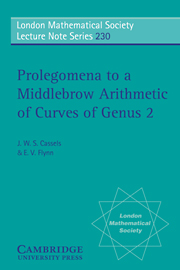Book contents
- Frontmatter
- Contents
- Foreword
- Background and conventions
- Chapter 1 Curves of genus 2
- Chapter 2 Construction of the jacobian
- Chapter 3 The Kummer surface
- Chapter 4 The dual of the Kummer
- Chapter 5 Weddle's surface
- Chapter 6 ℭ/2ℭ
- Chapter 7 The jacobian over local fields. Formal groups
- Chapter 8 Torsion
- Chapter 9 The isogeny. Theory
- Chapter 10 The isogeny. Applications
- Chapter 11 Computing the Mordell-Weil group
- Chapter 12 Heights
- Chapter 13 Rational points. Chabauty's Theorem
- Chapter 14 Reducible jacobians
- Chapter 15 The endomorphism ring
- Chapter 16 The desingularized Kummer
- Chapter 17 A neoclassical approach
- Chapter 18 Zukunftsmusik
- Appendix I MAPLE programs
- Appendix II Files available by anonymous ftp
- Bibliography
- Index rerum et personarum
Chapter 14 - Reducible jacobians
Published online by Cambridge University Press: 10 November 2010
- Frontmatter
- Contents
- Foreword
- Background and conventions
- Chapter 1 Curves of genus 2
- Chapter 2 Construction of the jacobian
- Chapter 3 The Kummer surface
- Chapter 4 The dual of the Kummer
- Chapter 5 Weddle's surface
- Chapter 6 ℭ/2ℭ
- Chapter 7 The jacobian over local fields. Formal groups
- Chapter 8 Torsion
- Chapter 9 The isogeny. Theory
- Chapter 10 The isogeny. Applications
- Chapter 11 Computing the Mordell-Weil group
- Chapter 12 Heights
- Chapter 13 Rational points. Chabauty's Theorem
- Chapter 14 Reducible jacobians
- Chapter 15 The endomorphism ring
- Chapter 16 The desingularized Kummer
- Chapter 17 A neoclassical approach
- Chapter 18 Zukunftsmusik
- Appendix I MAPLE programs
- Appendix II Files available by anonymous ftp
- Bibliography
- Index rerum et personarum
Summary
Introduction. It can happen that an abelian variety of dimension 2 is isogenous to a product of two (not necessarily distinct) abelian varieties of dimension 1, i.e. elliptic curves. The first example of this seems to have given by Legendre at the age of 80 in the troisième supplément to his Théorie des fonctions elliptiques: in a review Jacobi (1832) gave one form of Theorem 1.1 below. There are infinitely many cases indexed by a natural number as parameter, but Jacobi's is particularly straightforward. We have already met it in Chapter 9, where it had to be excluded from the discussion. We shall treat it in this chapter. It occurs quite frequently for naturally arising curves. The other cases of reducibility appear to be much more difficult to handle, and we do not make the attempt. There is a treatment in Frey & Kani (1991) and a rather inconclusive discussion of the construction of explicit examples in Frey (1995). For a different approach and further references, see Kuhn (1988). See also Ruppert (1990) [use of the complex structure], Grant (1994c) [use of L-functions], Stoll (1995), pp. 1343–1344 [use of L-functions], and Flynn, Poonen & Schaefer (1995) [simple proof of irreducibility in a special case with probable wide applicability].
The straightforward case. Since what we are doing in this section is geometry, we work in the algebraic closure. We say that two curves Y2 = F(X) are equivalent if they are taken into one another by a fractional linear transformation of X and the related transformation of Y [see (1.1.3)].
- Type
- Chapter
- Information
- Prolegomena to a Middlebrow Arithmetic of Curves of Genus 2 , pp. 154 - 159Publisher: Cambridge University PressPrint publication year: 1996

